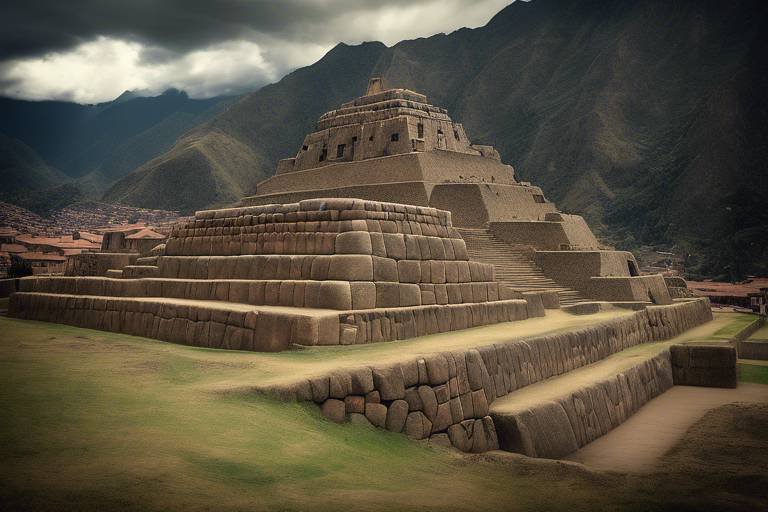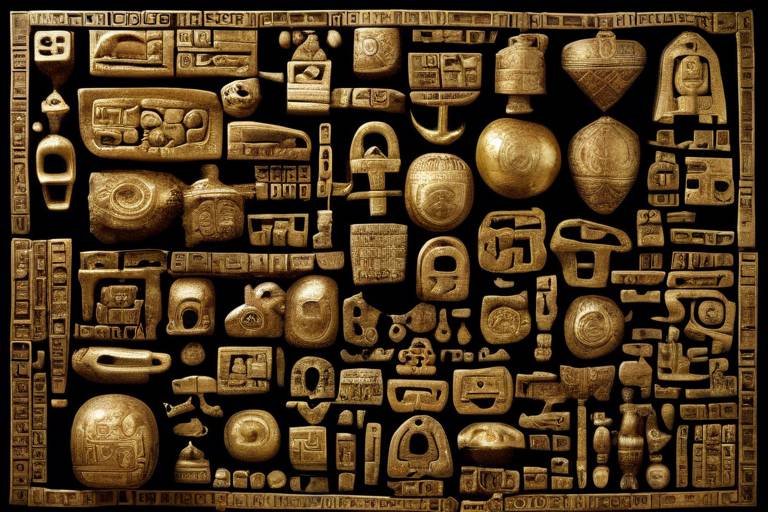The Secrets of the Babylonian Civilization - A Historical Insight
Step back in time and immerse yourself in the enigmatic world of the Babylonian civilization, a society shrouded in mystery yet renowned for its remarkable advancements in various fields. From its humble beginnings as a small Akkadian town to its zenith as a powerful city-state under the rule of Hammurabi, Babylon has left an indelible mark on history.
As we unravel the secrets of this ancient civilization that thrived in the fertile lands of Mesopotamia, we are transported to a realm of awe-inspiring urban development, sophisticated legal systems, and profound cultural achievements. The very essence of Babylon beckons us to explore its origins, culture, achievements, and eventual decline.
At the heart of Babylon lies a rich tapestry of culture and society, where art, literature, religion, and social structures intertwined to create a vibrant community. The everyday life of Babylonian citizens, with its intricate customs and rituals, offers us a glimpse into a world both familiar and exotic.
Delve deeper, and you will uncover the groundbreaking contributions of the Babylonians in the realms of science and technology. Their advancements in astronomy, mathematics, and engineering paved the way for future innovations, leaving an enduring legacy that continues to inspire awe.
One of the most enduring legacies of Babylon is Hammurabi's Code, a seminal set of laws that shaped the course of legal systems for centuries to come. The significance of this early legal framework cannot be overstated, as it laid the foundation for principles of justice and governance.
However, the glory of Babylon was not eternal, as internal strife, invasions, and environmental challenges eventually led to its decline. The once-mighty civilization faced a gradual unraveling, marking the end of an era that had captivated the ancient world.
Yet, the legacy of Babylon endures, its architectural wonders like the Hanging Gardens and the Ishtar Gate standing as testaments to a bygone era of grandeur. The influence of Babylon on art, literature, and legal principles reverberates through the annals of history, a reminder of the enduring power of human creativity.
As archaeologists rediscovered Babylon in the 19th and 20th centuries, new insights emerged, shedding light on the past glories of this ancient civilization. Ongoing excavations and preservation efforts continue to unravel the mysteries of Babylon, offering a tantalizing glimpse into its storied past.
Reflecting on the lessons of Babylon, we draw parallels between the challenges faced by this ancient society and those confronting the modern world. The rise and fall of Babylon serve as a poignant reminder of the fragility of civilizations and the enduring quest for knowledge and progress.

Origins of Babylon
The origins of Babylon trace back to a small Akkadian town located in Mesopotamia, a region known as the cradle of civilization. Over time, this modest settlement grew in prominence and power, eventually evolving into a formidable city-state under the rule of Hammurabi. The strategic location of Babylon along the Euphrates River played a crucial role in its development, facilitating trade and cultural exchange with neighboring regions. As Babylon flourished, it became a center of commerce and innovation, attracting skilled artisans, traders, and intellectuals from far and wide.

Babylonian Culture and Society
The Babylonian culture was a vibrant tapestry woven with art, literature, religion, and social structures that defined the society of that era. Art flourished in Babylon, with intricate sculptures and colorful murals adorning the city's buildings. Their literature, including epic poems like the Epic of Gilgamesh, reflected the values and beliefs of the Babylonian people, offering insights into their worldview.
Religion played a central role in Babylonian life, with a pantheon of gods and goddesses influencing every aspect of society. Temples dedicated to deities like Marduk and Ishtar stood as symbols of spiritual devotion, while rituals and ceremonies marked important occasions in the Babylonian calendar.
The social structure of Babylon was hierarchical, with the king at the pinnacle of power and authority. Beneath the ruler were nobles, priests, and scribes, followed by artisans, merchants, and farmers. Slavery was also prevalent in Babylon, with enslaved individuals performing various roles in society.
Everyday life in Babylon was a blend of work, leisure, and religious observance. Markets bustled with activity as traders bartered goods, while families gathered for meals in their homes. Festivals and celebrations punctuated the Babylonian calendar, offering moments of joy and community bonding.

Babylonian Achievements in Science and Technology
The Babylonian civilization made significant achievements in the fields of science and technology, leaving a lasting impact on human knowledge and innovation. One of the most notable contributions of the Babylonians was in astronomy, where they developed a sophisticated system of tracking celestial movements and creating accurate calendars. By observing the stars and planets, they laid the foundation for future astronomical studies.
In the realm of mathematics, the Babylonians were pioneers in the development of mathematical concepts and techniques. They introduced the concept of the number zero and a positional numeral system, which formed the basis for modern arithmetic. Their mathematical tablets, containing complex calculations and geometric formulas, showcase their advanced mathematical prowess.
Furthermore, the Babylonians excelled in engineering, constructing impressive structures that showcased their architectural ingenuity. The construction of the Ishtar Gate, a monumental entryway to the city of Babylon adorned with vibrant glazed bricks, stands as a testament to their engineering skills. This gate not only served as a symbol of Babylonian power but also demonstrated their mastery of construction techniques.
Moreover, the Babylonians were adept at irrigation and water management, essential for sustaining their agricultural practices in the fertile lands of Mesopotamia. Their innovative methods of canal construction and water distribution allowed for efficient farming and ensured the prosperity of their civilization.
Overall, the Babylonian achievements in science and technology highlight their advanced knowledge and ingenuity, laying the groundwork for future advancements in these fields.

Hammurabi's Code
One of the most significant aspects of Babylonian civilization is Hammurabi's Code, a set of laws that dates back to around 1754 BC. Hammurabi, the sixth king of Babylon, is renowned for creating this comprehensive legal code that governed various aspects of Babylonian society. The code consists of 282 laws that cover a wide range of subjects, including criminal justice, civil matters, and family law.
What sets Hammurabi's Code apart is its principle of "an eye for an eye, a tooth for a tooth," which reflects the concept of retributive justice. This notion of proportional punishment aimed to maintain order and ensure fairness in resolving disputes. The code also established different penalties based on social status, with distinctions made between nobles, commoners, and slaves.
Furthermore, Hammurabi's Code emphasized the idea of collective responsibility, holding entire communities accountable for the actions of individuals. This communal approach to justice fostered a sense of unity and mutual obligation among Babylonian citizens. The code also addressed issues such as property rights, trade regulations, and the protection of vulnerable members of society.
Through Hammurabi's Code, the Babylonians sought to create a harmonious and orderly society where justice prevailed. The laws were prominently displayed in public places for all to see, symbolizing the king's commitment to upholding justice and maintaining social cohesion. Despite its ancient origins, Hammurabi's Code laid the foundation for many legal principles that continue to influence modern legal systems.

Decline of Babylon
The decline of Babylon marked a tumultuous period in the history of this once-great civilization. Several factors contributed to the downfall of Babylon, leading to its eventual collapse. One significant factor was the series of invasions that plagued the region, weakening Babylon's defenses and infrastructure. The constant threat of external attacks put a strain on the city-state's resources and stability, making it increasingly vulnerable to outside forces.
Internal strife also played a crucial role in the decline of Babylon. Political unrest, power struggles, and social unrest within the city-state eroded the unity and cohesion that had once defined Babylonian society. The lack of effective leadership and governance further exacerbated the internal divisions, creating a fertile ground for chaos and instability to take hold.
Environmental challenges added to the woes of Babylon, as the region faced natural disasters such as droughts, floods, and famine. These environmental catastrophes disrupted agricultural production, the backbone of Babylonian economy, leading to food shortages and economic hardships. The inability to effectively manage and mitigate the impact of these environmental challenges weakened Babylon's resilience and ability to sustain itself.
As the external threats, internal conflicts, and environmental crises continued to escalate, Babylon gradually lost its former glory and power. The once-proud city-state crumbled under the weight of these challenges, ultimately succumbing to its enemies and fading into obscurity. The decline of Babylon serves as a cautionary tale of the fragility of even the most advanced civilizations and the importance of addressing internal and external threats to ensure survival and prosperity.

Legacy of Babylon
The legacy of Babylon continues to captivate the modern world with its architectural marvels and cultural impact. One of the most renowned legacies of Babylon is the Hanging Gardens, considered one of the Seven Wonders of the Ancient World. These lush and verdant terraced gardens, believed to have been built by King Nebuchadnezzar II for his wife, showcase the ingenuity and engineering prowess of the Babylonians.
Furthermore, Babylon's influence on art and literature is undeniable. The epic of Gilgamesh, an ancient Mesopotamian poem, originates from Babylonian culture and remains a cornerstone of world literature. The intricate bas-reliefs and cuneiform inscriptions found in Babylonian art reflect a sophisticated artistic tradition that has inspired generations.
Legal principles established in Babylon, particularly through Hammurabi's Code, have left a lasting impact on the development of legal systems worldwide. The concept of justice and equality embodied in these laws continues to shape modern legal philosophy and practice.
Moreover, Babylon's architectural achievements, such as the Ishtar Gate, with its vibrant glazed bricks depicting mythical creatures, showcase the artistic prowess and grandeur of this ancient civilization. The gate symbolized the city's cultural richness and power, leaving a lasting impression on visitors and historians alike.
In addition to its tangible legacies, Babylon's cultural and intellectual contributions have permeated through the ages, influencing various aspects of modern society. The legacy of Babylon serves as a reminder of the enduring impact of ancient civilizations on contemporary thought, art, and governance.

Rediscovery of Babylon
Rediscovering Babylon has been a fascinating journey for archaeologists over the past two centuries. The ancient city, once a powerful center of civilization, was lost to time and buried beneath layers of earth. However, in the 19th and 20th centuries, explorers and researchers began to unearth the remnants of this legendary city, bringing its secrets back to light.
Excavations in Babylon have revealed a wealth of information about its urban layout, architectural marvels, and cultural practices. The Ishtar Gate, adorned with vibrant glazed bricks depicting mythical creatures, stands as a testament to the artistic prowess of the Babylonians. The Hanging Gardens, one of the Seven Wonders of the Ancient World, have captured the imagination of people for centuries.
Archaeologists have meticulously pieced together the puzzle of Babylon, uncovering temples, palaces, and infrastructure that showcase the advanced engineering skills of the ancient Babylonians. Inscriptions and artifacts have provided insights into their religious beliefs, social hierarchies, and daily life.
The ongoing efforts to preserve and study the remains of Babylon continue to shed light on this enigmatic civilization. Modern technologies and methodologies have allowed researchers to delve deeper into the history and legacy of Babylon, unraveling its mysteries and connecting the past to the present.

Lessons from Babylon for the Modern World
As we gaze back into the annals of history and unravel the secrets of the Babylonian civilization, we find a treasure trove of wisdom that resonates even in the modern world. The rise and fall of Babylon offer profound lessons that transcend time and space, offering insights that are as relevant today as they were thousands of years ago.
One of the key lessons that Babylon imparts to the modern world is the importance of strong leadership and governance. Hammurabi's Code, with its emphasis on justice and fairness, serves as a timeless reminder of the need for a just legal system to maintain social order and harmony. The principles embedded in Hammurabi's Code continue to influence legal frameworks around the globe, highlighting the enduring impact of Babylonian legal traditions.
Moreover, the Babylonian civilization teaches us the significance of cultural exchange and innovation. The diverse cultural tapestry of Babylon, marked by the blending of Sumerian, Akkadian, and Assyrian influences, underscores the value of embracing diversity and fostering creativity. In a world that is increasingly interconnected, the Babylonian model of cultural synthesis serves as a beacon of inspiration for building inclusive societies and nurturing creativity.
Additionally, the environmental challenges that contributed to the decline of Babylon serve as a cautionary tale for the modern world. The unsustainable exploitation of natural resources, coupled with environmental degradation, hastened the downfall of this once-great civilization. As we grapple with pressing environmental issues today, the story of Babylon reminds us of the urgent need to adopt sustainable practices and protect our planet for future generations.
Furthermore, the legacy of Babylon in the realms of art, architecture, and literature underscores the enduring power of creativity and imagination. The architectural marvels of Babylon, such as the legendary Hanging Gardens, continue to inspire awe and wonder, showcasing the transformative impact of human ingenuity. In a world that is constantly evolving, the legacy of Babylon serves as a testament to the enduring power of creativity and innovation.
In essence, the lessons from Babylon for the modern world are manifold and profound. From the importance of just governance to the value of cultural exchange and environmental stewardship, the legacy of Babylon continues to offer invaluable insights that resonate across time and space. By reflecting on the rise and fall of this ancient civilization, we can glean wisdom that has the potential to shape a more enlightened and sustainable future for all.
Frequently Asked Questions
- What was the significance of Babylon in ancient Mesopotamia?
Babylon was a prominent city-state in ancient Mesopotamia known for its advanced urban development, legal systems, and cultural achievements. It was a center of trade, innovation, and intellectual pursuits, making it a key player in the region's history.
- Who was Hammurabi and what was his Code?
Hammurabi was a Babylonian king known for his famous legal code, one of the earliest known sets of laws in human history. His Code of Hammurabi established rules and punishments to govern society, promoting justice and order in Babylonian civilization.
- What were some of the notable achievements of the Babylonians in science and technology?
The Babylonians made significant contributions to fields such as astronomy, mathematics, and engineering. They developed advanced mathematical concepts, such as the Babylonian numeral system, and constructed impressive structures like the Ishtar Gate, showcasing their expertise and innovation.
- How did Babylon influence modern art, literature, and legal systems?
Babylon's cultural and architectural legacy continues to inspire modern art, literature, and legal principles. Its architectural wonders like the Hanging Gardens and the enduring impact of Hammurabi's Code have left a lasting imprint on various aspects of contemporary society.
- What lessons can we learn from the rise and fall of Babylon?
Studying the history of Babylon offers valuable insights into the consequences of societal challenges, power struggles, and environmental issues. By reflecting on the successes and failures of this ancient civilization, we can draw parallels to contemporary issues and strive for sustainable progress and resilience.



















